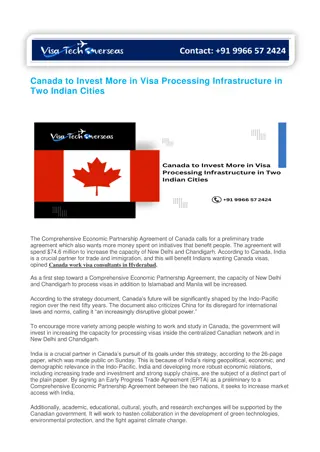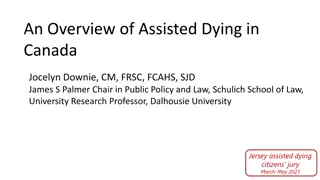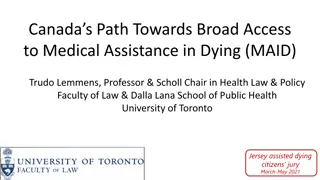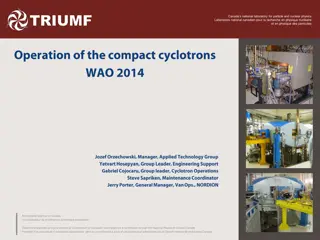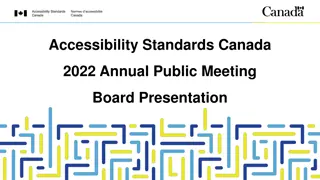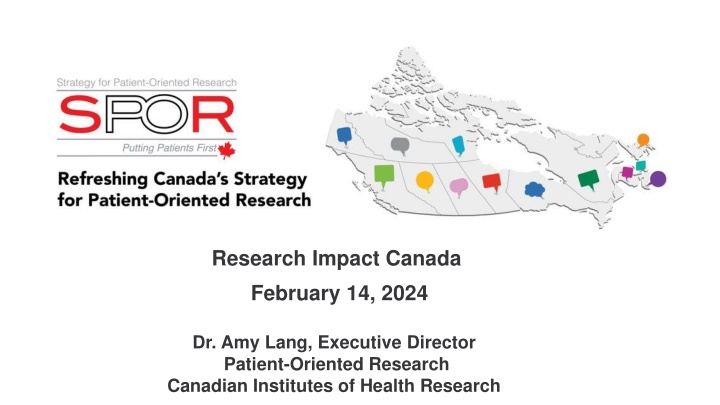
Enhancing Research Impact: Patient-Oriented Research and SPOR Strategy in Canada
Discover the significance of Patient-Oriented Research (POR) and Canada's Strategy for Patient-Oriented Research (SPOR) in improving health outcomes. Learn about POR's focus on collaboration with policymakers and health services for increased research impact, while SPOR follows strategic principles to maximize research relevance and mobilize knowledge effectively. Explore how POR advances research excellence, relevance, and impact by engaging lived and professional experiences to address community needs. SPOR funding supports various units, networks, and platforms across Canada to promote innovative clinical trials and data utilization.
Download Presentation

Please find below an Image/Link to download the presentation.
The content on the website is provided AS IS for your information and personal use only. It may not be sold, licensed, or shared on other websites without obtaining consent from the author. If you encounter any issues during the download, it is possible that the publisher has removed the file from their server.
You are allowed to download the files provided on this website for personal or commercial use, subject to the condition that they are used lawfully. All files are the property of their respective owners.
The content on the website is provided AS IS for your information and personal use only. It may not be sold, licensed, or shared on other websites without obtaining consent from the author.
E N D
Presentation Transcript
Research Impact Canada February 14, 2024 Dr. Amy Lang, Executive Director Patient-Oriented Research Canadian Institutes of Health Research
Session Objectives 1. Introduction to POR and SPOR program basics 2. Overview: SPOR Strategy Refresh 3. Discuss a theme relevant to both SPOR and Research Impact Canada mandates Strengthening collaboration with policymakers and health services to increase research impact
What is Patient-Oriented Research (POR) ? Patient-Oriented Research engages people with lived and living experience (PWLLE) and knowledge users to increase the excellence, relevance and impact of research
POR Advances Research Impact Excellence Relevance Impact POR leverages insight that is gained through lived and professional experience POR produces knowledge that is more likely to be used in health policy, delivery and decisions POR focuses on issues that matter to people and communities we serve
What is Canadas Strategy for Patient-Oriented Research (SPOR)? Vision By 2025, Canada will have demonstrably improved health outcomes and enhanced the health care experience for patients through the integration of evidence at all levels of the health care system. - Canada s Strategy for Patient-Oriented Research - 2011
SPOR is Guided by 4 Strategic Principles Engagementof patients and other knowledge users to maximize relevance of research Partnered funding to increase reach, buy-in and knowledge mobilization Investment in capacity building to grow the skills, knowledge and relationships required to sustain patient-oriented research Investment in infrastructure to enable patient-oriented research
What does SPOR Fund? 11 SPOR SUPPORT Units 6 Networks 1 Canadian Primary Care Research Network 11 Research Networks across Canada Nunavut SPOR SU Cross-cutting platforms: SPOR Evidence Alliance National Training Entity (Passerelle) SPOR Canadian Data Platform $11.7M annually to Innovative Clinical Trials SPOR Canadian Data Platform
SPOR is making a difference For every dollar that CIHR committed to SPOR, competition and applicant partners committed $1.16 SPOR-funded research has been cited in policy documents at approximately 2.7 times the global average 229 evidence synthesis requests from 52 different organizations completed by SPOR Evidence Alliance (including 42 Evidence Syntheses related to COVID-19). 100% of all queries were implemented in policy and practice decision-making. SPOR teams mobilized quickly to respond during COVID. Over 500 distinct COVID-19 related research activities across SPOR SPOR is providing critical resources to smaller jurisdictions, and is building capacity for health research in partnership with Indigenous communities in the north
Why a SPOR Refresh? Started 10+ years ago Many changes in health research and health systems An opportunity to build on successes to date and lessons learned, while also reflecting evolving patient, community, and health system priorities
Themes to inform a refreshed SPOR 1. Strengths and challenges for the program overall 2. Important trends and emerging needs of the future 3. Delivering on Truth and Reconciliation Commission (TRC) Calls to Action and Accelerating First Nations, M tis and Inuit self- determination in health research through SPOR 4. Strengthening equity, diversity, inclusion, antiracism and accessibility in patient engagement and POR 5. Building capacity for excellence in patient-oriented research 6. Strengthening collaboration with policymakers and health services to increase research impact 7. Strengthening governance for Canada s Strategy for Patient-Oriented Research
Strengthening Collaboration with Policy & Health System Decision-Makers to Increase Impact Context: Over the past four decades, researchers have been writing about the health research-policy-practice gap. Integrating and communicating research findings into health policy and service delivery has been an ongoing challenge. SPOR has tried to address this challenge by creating partnerships based on learning and collaboration between researchers and decision-makers.
Increasing Research Impact: SPOR Successes A recent evaluation suggests that the SPOR program has made progress in strengthening collaborations with policy makers and health services to increase research impact. o Many SPOR-funded entities report informing policies and participating at decision-making tables. o Several SPOR-funded projects have achieved impacts in primary care reform, cost avoidance, re-design of services, and generated relevant and timely knowledge products, which have influenced practice, policy, and public health guidelines. o SPOR research cited in policy documents ~2.7 times the global avg.
Increasing Research Impact: SPOR Challenges Certain collaborations within the SPOR ecosystem have been inconsistent or not as successful. o Low levels of awareness of SPOR among senior leadership in some provinces and territories. o Little evidence to demonstrate that SPOR s collaborations with policy and health system decision-makers has contributed to the improvement of patient health care experiences, health outcomes or health system outcomes. Possibly, it is too early to expect such improvements from SPOR- funded research (it can take as long as 20 years to realize research impacts).
Discussion Question Roundtable Discussion 1 What key elements support successful collaboration between researchers and policymakers, that should be sustained or strengthened?
Breakout Activity Small Group Discussion How can SPOR support research to be more actionable for policy and health system decision-makers?
Breakout Room Instructions 1. Go into your respective breakout groups. 2. Identify a reporter. 3. Brainstorm and capture responses to the discussion questions on paper or electronically 4. Reconvene all together in the main session to share your group s comments.
Discussion Question Roundtable Discussion 2 What challenges do health researchers and health decision- makers face in collaborating effectively, and what design elements of SPOR could help to overcome these challenges?
Thank you! Visit the online public engagement platform : https://letstalk-cihr.ca/spor- refresh We invite you to continue the conversation! See what others are saying and share your ideas until March 31, 2024.






